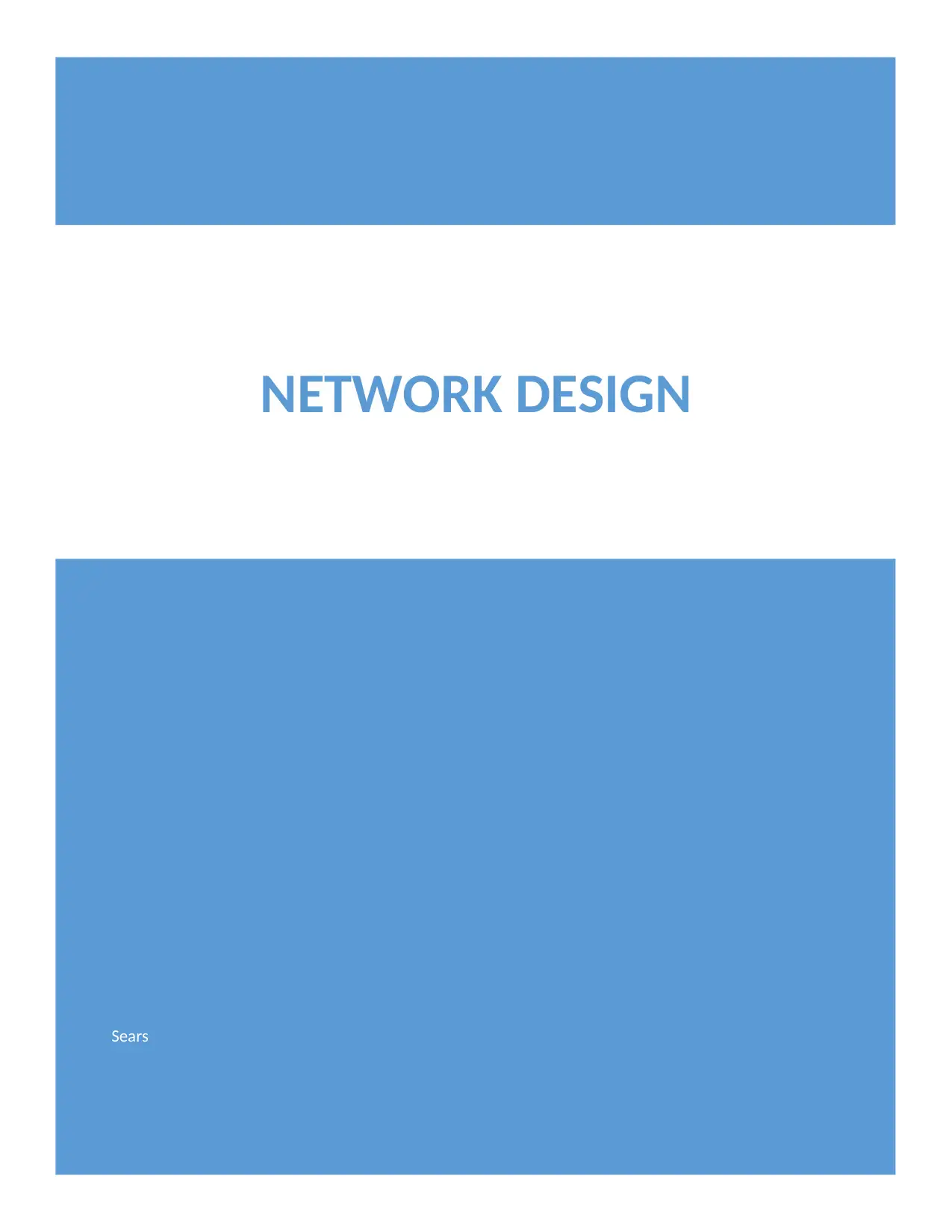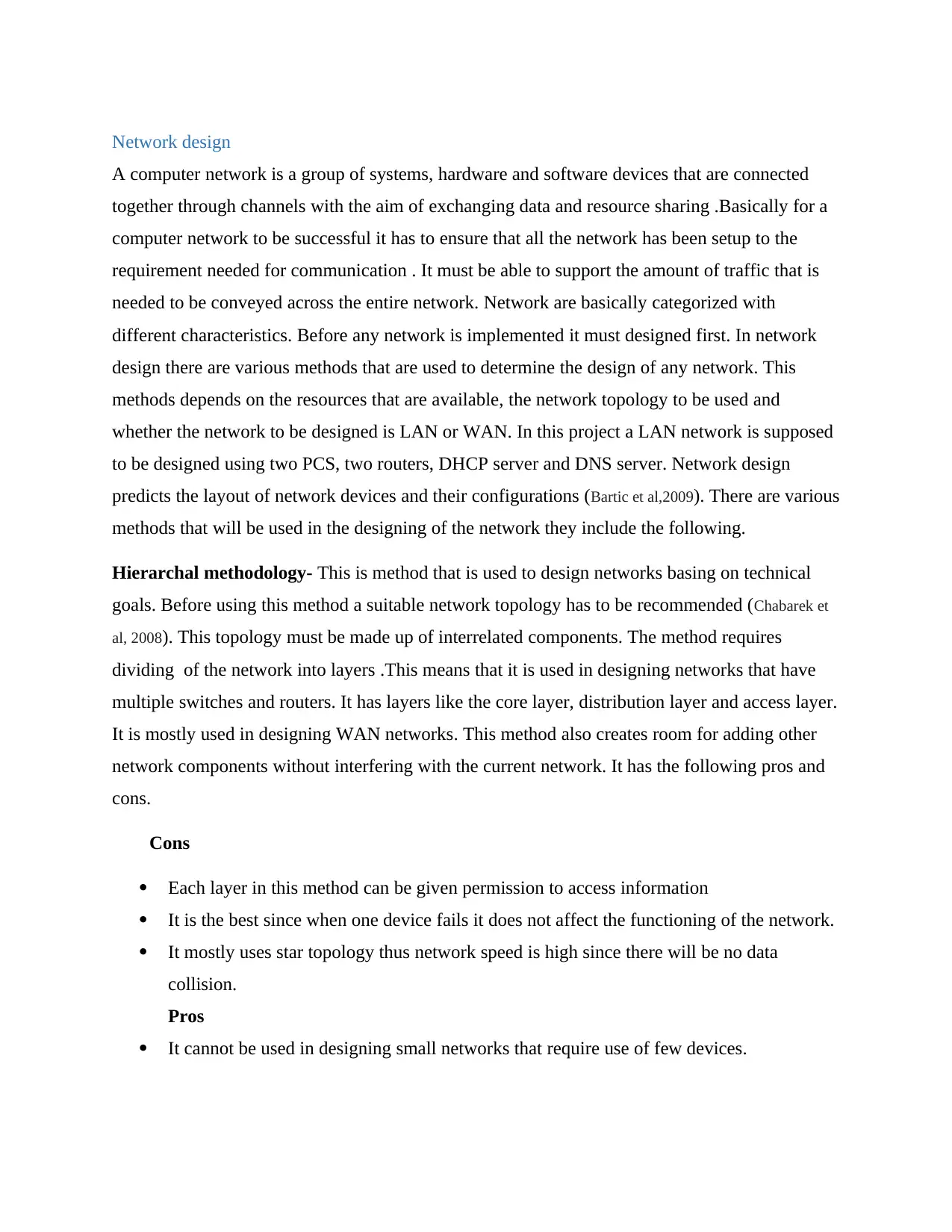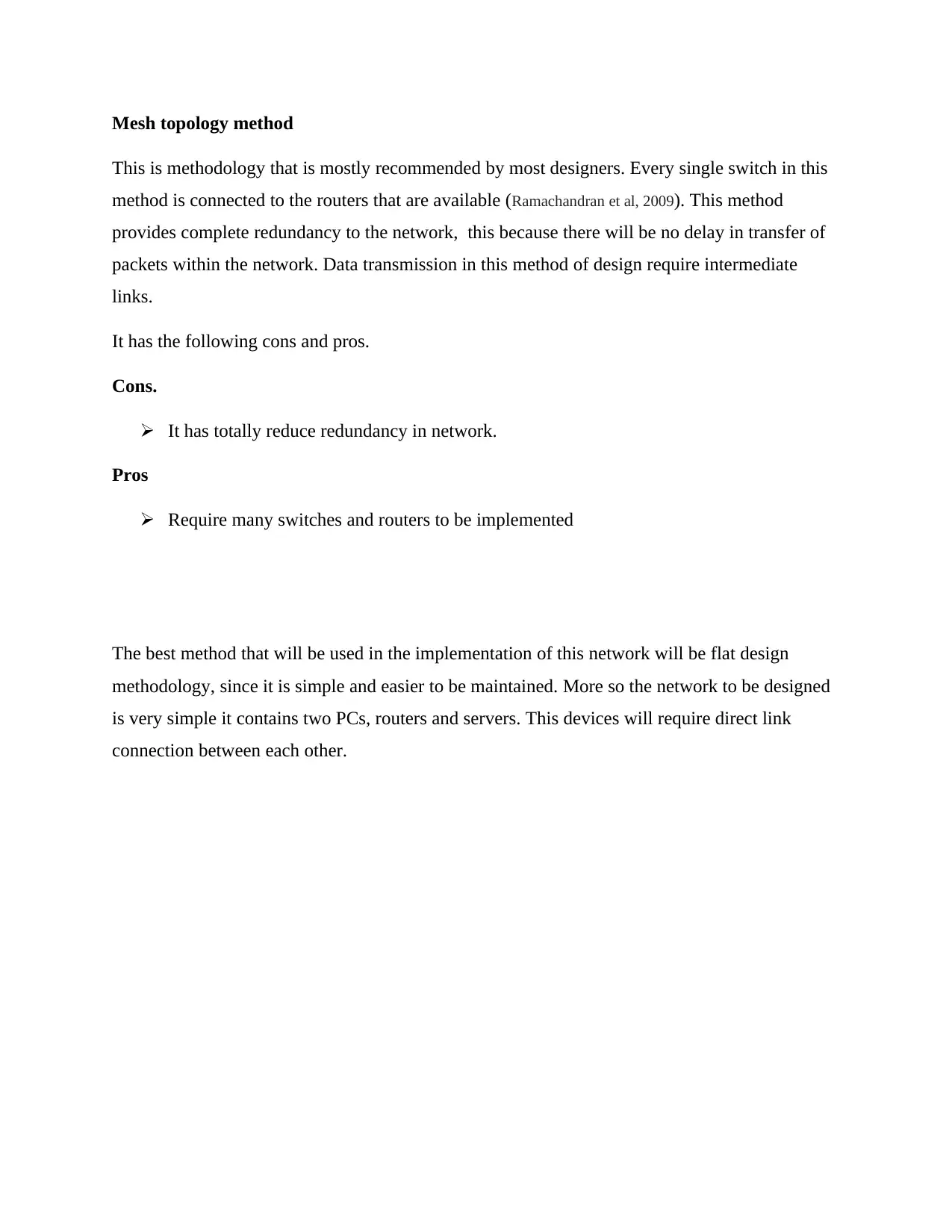Selecting a Network Design Methodology: Justification for Assessment 4
VerifiedAdded on 2023/06/08
|5
|908
|264
Report
AI Summary
This report discusses various network design methodologies, including hierarchical, flat, and mesh topologies, to determine the most suitable approach for a LAN network implementation involving two PCs, two routers, a DHCP server, and a DNS server. The analysis evaluates the pros and cons of each method, ultimately recommending the flat design methodology due to its simplicity and ease of maintenance, aligning with the project's requirements for a straightforward network configuration. The report also references academic sources to support the evaluation and selection process. Desklib provides a platform to access similar solved assignments and study resources.

Sears
NETWORK DESIGN
NETWORK DESIGN
Paraphrase This Document
Need a fresh take? Get an instant paraphrase of this document with our AI Paraphraser

Network design
A computer network is a group of systems, hardware and software devices that are connected
together through channels with the aim of exchanging data and resource sharing .Basically for a
computer network to be successful it has to ensure that all the network has been setup to the
requirement needed for communication . It must be able to support the amount of traffic that is
needed to be conveyed across the entire network. Network are basically categorized with
different characteristics. Before any network is implemented it must designed first. In network
design there are various methods that are used to determine the design of any network. This
methods depends on the resources that are available, the network topology to be used and
whether the network to be designed is LAN or WAN. In this project a LAN network is supposed
to be designed using two PCS, two routers, DHCP server and DNS server. Network design
predicts the layout of network devices and their configurations (Bartic et al,2009). There are various
methods that will be used in the designing of the network they include the following.
Hierarchal methodology- This is method that is used to design networks basing on technical
goals. Before using this method a suitable network topology has to be recommended (Chabarek et
al, 2008). This topology must be made up of interrelated components. The method requires
dividing of the network into layers .This means that it is used in designing networks that have
multiple switches and routers. It has layers like the core layer, distribution layer and access layer.
It is mostly used in designing WAN networks. This method also creates room for adding other
network components without interfering with the current network. It has the following pros and
cons.
Cons
Each layer in this method can be given permission to access information
It is the best since when one device fails it does not affect the functioning of the network.
It mostly uses star topology thus network speed is high since there will be no data
collision.
Pros
It cannot be used in designing small networks that require use of few devices.
A computer network is a group of systems, hardware and software devices that are connected
together through channels with the aim of exchanging data and resource sharing .Basically for a
computer network to be successful it has to ensure that all the network has been setup to the
requirement needed for communication . It must be able to support the amount of traffic that is
needed to be conveyed across the entire network. Network are basically categorized with
different characteristics. Before any network is implemented it must designed first. In network
design there are various methods that are used to determine the design of any network. This
methods depends on the resources that are available, the network topology to be used and
whether the network to be designed is LAN or WAN. In this project a LAN network is supposed
to be designed using two PCS, two routers, DHCP server and DNS server. Network design
predicts the layout of network devices and their configurations (Bartic et al,2009). There are various
methods that will be used in the designing of the network they include the following.
Hierarchal methodology- This is method that is used to design networks basing on technical
goals. Before using this method a suitable network topology has to be recommended (Chabarek et
al, 2008). This topology must be made up of interrelated components. The method requires
dividing of the network into layers .This means that it is used in designing networks that have
multiple switches and routers. It has layers like the core layer, distribution layer and access layer.
It is mostly used in designing WAN networks. This method also creates room for adding other
network components without interfering with the current network. It has the following pros and
cons.
Cons
Each layer in this method can be given permission to access information
It is the best since when one device fails it does not affect the functioning of the network.
It mostly uses star topology thus network speed is high since there will be no data
collision.
Pros
It cannot be used in designing small networks that require use of few devices.

Flat design methodology
This is the topology that is mostly used in designing small networks. There is no
hierarchy in this design (Sandberg et al,2013). Each device that is found in this method has
the same function in the network, since the network is not divide into many layers.
Designing of networks using this method is very easy. The networks that are designed
using this method are very easy to be maintained (Sandberg et al., 2013). It has the following
advantages and disadvantages.
Cons
It is easy to be designed.
Can be easily maintained.
Best for LAN connection
Pros
The network cannot be expanded.
Troubleshooting the network is very difficult
This is the topology that is mostly used in designing small networks. There is no
hierarchy in this design (Sandberg et al,2013). Each device that is found in this method has
the same function in the network, since the network is not divide into many layers.
Designing of networks using this method is very easy. The networks that are designed
using this method are very easy to be maintained (Sandberg et al., 2013). It has the following
advantages and disadvantages.
Cons
It is easy to be designed.
Can be easily maintained.
Best for LAN connection
Pros
The network cannot be expanded.
Troubleshooting the network is very difficult
⊘ This is a preview!⊘
Do you want full access?
Subscribe today to unlock all pages.

Trusted by 1+ million students worldwide

Mesh topology method
This is methodology that is mostly recommended by most designers. Every single switch in this
method is connected to the routers that are available (Ramachandran et al, 2009). This method
provides complete redundancy to the network, this because there will be no delay in transfer of
packets within the network. Data transmission in this method of design require intermediate
links.
It has the following cons and pros.
Cons.
It has totally reduce redundancy in network.
Pros
Require many switches and routers to be implemented
The best method that will be used in the implementation of this network will be flat design
methodology, since it is simple and easier to be maintained. More so the network to be designed
is very simple it contains two PCs, routers and servers. This devices will require direct link
connection between each other.
This is methodology that is mostly recommended by most designers. Every single switch in this
method is connected to the routers that are available (Ramachandran et al, 2009). This method
provides complete redundancy to the network, this because there will be no delay in transfer of
packets within the network. Data transmission in this method of design require intermediate
links.
It has the following cons and pros.
Cons.
It has totally reduce redundancy in network.
Pros
Require many switches and routers to be implemented
The best method that will be used in the implementation of this network will be flat design
methodology, since it is simple and easier to be maintained. More so the network to be designed
is very simple it contains two PCs, routers and servers. This devices will require direct link
connection between each other.
Paraphrase This Document
Need a fresh take? Get an instant paraphrase of this document with our AI Paraphraser

References
Bartic, T. A., Mignolet, J. Y., Nollet, V., Marescaux, T., Verkest, D., Vernalde, S., & Lauwereins, R. (2009).
Topology adaptive network-on-chip design and implementation. IEE Proceedings-Computers and Digital
Techniques, 152(4), 467-472.
Chabarek, J., Sommers, J., Barford, P., Estan, C., Tsiang, D., & Wright, S. (2008, April). Power awareness in
network design and routing. In INFOCOM 2008. The 27th Conference on Computer Communications.
IEEE (pp. 457-465). IEEE.
Sandberg, R., Goldberg, D., Kleiman, S., Walsh, D., & Lyon, B. (2013, June). Design and implementation of the
Sun network filesystem. In Proceedings of the Summer USENIX conference (pp. 119-130).
Ramachandran, K., Buddhikot, M., Chandranmenon, G., Miller, S., Belding-Royer, E., & Almeroth, K. (2009,
September). On the design and implementation of infrastructure mesh networks. In Proceedings of the
IEEE Workshop on Wireless Mesh Networks (WiMesh) (pp. 4-15). IEEE Press.
Bartic, T. A., Mignolet, J. Y., Nollet, V., Marescaux, T., Verkest, D., Vernalde, S., & Lauwereins, R. (2009).
Topology adaptive network-on-chip design and implementation. IEE Proceedings-Computers and Digital
Techniques, 152(4), 467-472.
Chabarek, J., Sommers, J., Barford, P., Estan, C., Tsiang, D., & Wright, S. (2008, April). Power awareness in
network design and routing. In INFOCOM 2008. The 27th Conference on Computer Communications.
IEEE (pp. 457-465). IEEE.
Sandberg, R., Goldberg, D., Kleiman, S., Walsh, D., & Lyon, B. (2013, June). Design and implementation of the
Sun network filesystem. In Proceedings of the Summer USENIX conference (pp. 119-130).
Ramachandran, K., Buddhikot, M., Chandranmenon, G., Miller, S., Belding-Royer, E., & Almeroth, K. (2009,
September). On the design and implementation of infrastructure mesh networks. In Proceedings of the
IEEE Workshop on Wireless Mesh Networks (WiMesh) (pp. 4-15). IEEE Press.
1 out of 5
Related Documents
Your All-in-One AI-Powered Toolkit for Academic Success.
+13062052269
info@desklib.com
Available 24*7 on WhatsApp / Email
![[object Object]](/_next/static/media/star-bottom.7253800d.svg)
Unlock your academic potential
Copyright © 2020–2025 A2Z Services. All Rights Reserved. Developed and managed by ZUCOL.





